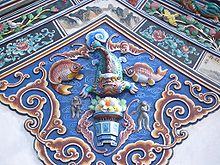- Malaysian Chinese religion
-
 Picture of Malaysian Chinese shrine of Na Tuk Kong.
Picture of Malaysian Chinese shrine of Na Tuk Kong.
Malaysian Chinese religion refers to religious beliefs of Chinese origin as practiced by the sizable Chinese minority of Malaysia. These beliefs and practices are heavily influenced by the three faiths practiced by Chinese communities, Confucianism, Buddhism, and Taoism.
According to The Encyclopedia of Malaysia, vol. Religions & Beliefs, statistics from the 2000 census indicate that around 20% of the population, mainly Malaysian Chinese, are Buddhist and a further 3% follow Chinese religions including Confucianism and Taoism. The Chinese folk beliefs in Malaysia include beliefs in local guardian spirits which originated from traditional animism and mysticism, and the worship of sacred monks and spirits popular among the Thais, also elevated local heroes and leaders to patron saints and guardians.
Contents
History
The Encyclopedia of Malaysia states that the early history of Malaysian Chinese religions traces back to the 15th century, with small settlements that were established in Melaka by Hokkien traders, but it was not until the 19th century that there was a mass migration of Chinese. They built shrines dedicated to their deities and cemeteries for those who died. The Chinese migration during the tin and gold mining days, which were a result of high demand for these products, prompted the need of temples, for practices and religious rituals. During that time, most immigrants were illiterate or poorly educated peasants and coolies, thus Buddhist and Taoist monks were brought over from China to run the temples.
Social organizations in the Chinese immigrant society were important, where surnames, dialect, locality and trade mattered. The Cantonese, Hokkien, Teochew and Hakka, respectively formed their secret societies, such as the Ghee Hin and Hai San, and they played as 'government' in controlling the Chinese immigrants. Local Malay chiefs called the Chinese leaders Kapitan Cina (literally, "Captain China" or "Chinese Captain"), who soon became patron saints of the Chinese. The evolution of Malaysian Chinese Religion was a mixture of local value and belief systems, where it produced some local deities such as the Na Tuk Kong and Tua Pek Kong.
Christianity
According to the Encyclopedia of Malaysia, there are records where Persian and Turkish traders with Nestorian Christian origins came around the year 650 CE, but it was not until the conquest of Malacca by the Portuguese in year 1511, that marked the introduction of Roman Catholicism. The Dutch colonial year of 1641 brought in Protestantism, and with the influx of Chinese and Indian immigrants during the 19th century, more Christian missionaries were imported. However there were small numbers of Chinese Christians, before the migration to Malaya.
Islam
In the Terengganu state, Jeram and Tepoh were two of the traditional Chinese-Muslim villages; their forefathers arrived together with Zheng He or much earlier. Dato' Haji Mustapha Ma Qi is among the well-known Malaysian Chinese-Muslims. He is the president of the Chinese Muslim Association (MACMA - Persatuan Cina Muslim Malaysia). According to the official census, there were about 40,000 Chinese Muslims in Malaysia as of 2000, mostly converts by request of Malay Muslim family-in-law.[1].
The Chinese acceptance of Islam as a religion can be traced back as early as the 7th century, from the Chinese Muslims' annals and the history of Islam in China. Guangzhou city has one of the earliest mosques, Huaisheng Mosque. Today in China, there are about over 20 million Muslims[2][3]. They can be identified by their surnames, especially Ma, Li, Chang, Zhang, Lan, Wu, Mi, Yang, etc. The famous Ma Shan Bao (Zheng He) was a friend of Parameswara , the ruler of Melaka in 1402.
Malaysian Chinese Deities
The name of deities listed here does not represent Chinese of The People's Republic of China. However the Deities listed here were tradition passed down from ancestors living in ancient China. Na Tuk Kong, in particular, was a localized Deity where the name derived from 'Dato', which is a local Malay word.
List of Malaysian Chinese Gods:
- Na Tuk Kong (Chinese : 拿督公)
- Celestial God Tnee Kong (Chinese : 天公)
- Earth God Teh Choo Kong (地主公), Tu Di Gong (Chinese : 土地公)
- Tua Pek Kong (Chinese : 大伯公)
- God of Prosperity Choy Sun Yeh / God of Fortune (Chinese : 财神)
- Kwan God Kwan Kong (Chinese : 關公)
- Kuan Yin originated from Sanskrit Avalokiteśvara (Chinese : 觀世音), commonly known as the Goddess of Mercy.
- Ma Zu (Chinese : 媽祖) is the Taoist Goddess of the Sea who protects fishermen and sailors.
- Di Zhu God (Chinese: 地主神) Lord of the Land Used.
Material suppliers
Malaysian Chinese Gods is also a thriving business in Malaysia, there are large numbers of suppliers and shops specialize in the materials of local Malaysian Chinese beliefs, such as joss sticks, dead people's money (Hell money), etc., they are commonly known as Gods Material Shop (Chinese : 神料商店).
List of Malaysian Chinese religions
 Three Teachings Chinese Temple, Kuala Lumpur
Three Teachings Chinese Temple, Kuala Lumpur
- Buddhism
- Taoism
- Confucianism
- Ancestor worship
- Superstition of Malaysian Chinese
- Fengshui
- Protestantism
- Catholicism
- Islam
- I-Kuan Tao
- De Jiao (Moral Uplifting Society)
See also
- Chinese religion
- Ancestor worship
- Superstition of Malaysian Chinese
- Fengshui
- Chinese folk religion
- Chinese mythology
- list of deities
- Gods Material Shop
References
- ^ Dept. of Statistics: "Population and Housing Census of Malaysia 2000", Table 4.1; p. 70, Kuala Lumpur: Department of Statistics Malaysia, 2001
- ^ CIA - The World Factbook - China
- ^ China (includes Hong Kong, Macau, and Tibet)
- The Encyclopedia of Malaysia, vol. Religions & Beliefs, edited by Prof. Dr M. Kamal Hassan & Dr. Ghazali bin Basri ISBN 981-3018-51-8 [1]
Categories:
Wikimedia Foundation. 2010.



